Connect With Us
vendor
Caring for Diabetic Foot Wounds
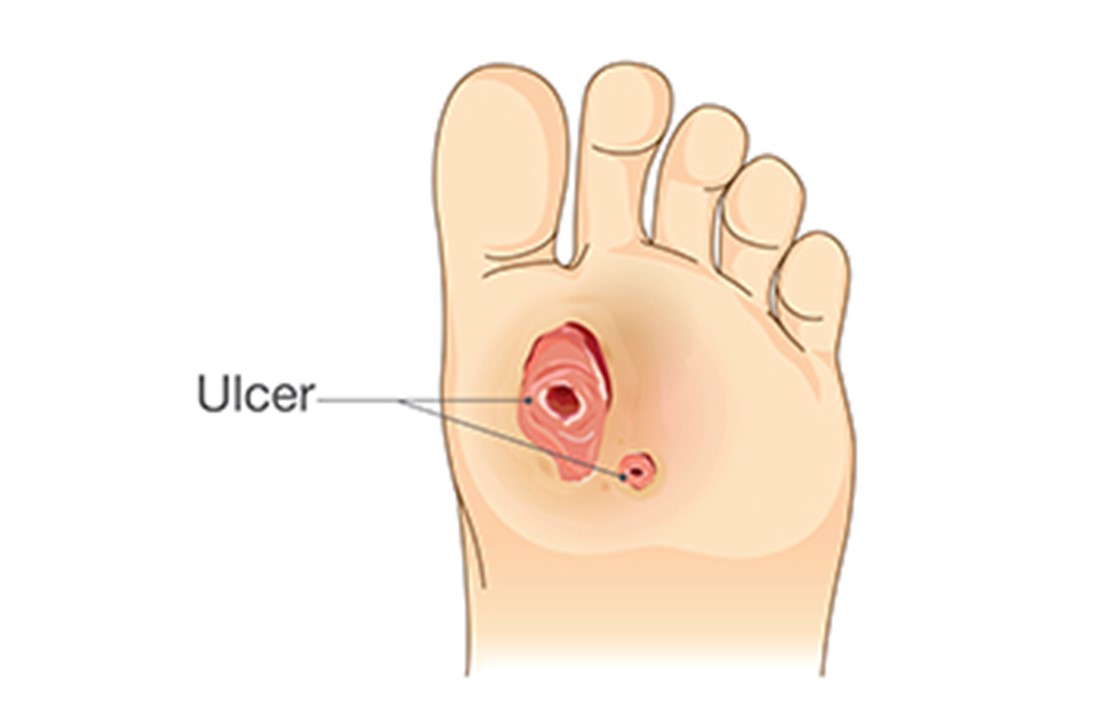 Managing diabetic foot wounds is important for individuals with diabetes, as they are susceptible to slow-healing wounds that can escalate into severe complications. First, meticulous wound care is essential. This can begin with cleaning the wound daily with mild soap and warm water, followed by applying an antibiotic ointment and covering with a sterile dressing. Offloading pressure from the affected foot is suggested, as this can be achieved with special footwear, custom orthotics, or using assistive devices, such as crutches. Regular monitoring for signs of infection, such as increased redness, swelling, or discharge, is vital. Keeping blood sugar levels under control is fundamental, as high blood sugar can impede the healing process. If you have diabetes, it is strongly suggested that you are under the care of a podiatrist who can help you to manage any foot wounds that may develop.
Managing diabetic foot wounds is important for individuals with diabetes, as they are susceptible to slow-healing wounds that can escalate into severe complications. First, meticulous wound care is essential. This can begin with cleaning the wound daily with mild soap and warm water, followed by applying an antibiotic ointment and covering with a sterile dressing. Offloading pressure from the affected foot is suggested, as this can be achieved with special footwear, custom orthotics, or using assistive devices, such as crutches. Regular monitoring for signs of infection, such as increased redness, swelling, or discharge, is vital. Keeping blood sugar levels under control is fundamental, as high blood sugar can impede the healing process. If you have diabetes, it is strongly suggested that you are under the care of a podiatrist who can help you to manage any foot wounds that may develop.
Diabetic foot care is important in preventing foot ailments such as ulcers. If you are suffering from diabetes or have any other concerns about your feet, contact one of our clinicians from The Footcare Centre. Our podiatrists can provide the care you need to keep you pain-free and on your feet.
Diabetic Foot Care
Diabetes affects millions of people every year. The condition can damage blood vessels in many parts of the body, especially the feet. Because of this, taking care of your feet is essential if you have diabetes, and having a podiatrist help monitor your foot health is highly recommended.
The Importance of Caring for Your Feet
- Routinely inspect your feet for bruises or sores.
- Wear socks that fit your feet comfortably.
- Wear comfortable shoes that provide adequate support.
Patients with diabetes should have their doctor monitor their blood levels, as blood sugar levels play such a huge role in diabetic care. Monitoring these levels on a regular basis is highly advised.
It is always best to inform your healthcare professional of any concerns you may have regarding your feet, especially for diabetic patients. Early treatment and routine foot examinations are keys to maintaining proper health, especially because severe complications can arise if proper treatment is not applied.
If you have any questions please feel free to contact our offices located in Weybridge, UK. We offer the newest diagnostic and treatment technologies for all your foot and ankle needs.
Diabetic Foot Care
Diabetes affects millions of people every year. Blood vessels located all over the body are damaged due to diabetes—even the blood vessels of the feet. Neuropathy, or nerve damage, can result from slower blood flow in the legs and feet. In diabetic patients, neuropathy is very important to monitor, as diabetics are at risk for developing ulcers.
Always washing and thoroughly drying the feet are pertinent parts of diabetic foot care. There should be a focus on cleaning between the toes. Even if no pain is felt, the entire foot should be examined for redness and sores. Neuropathy can often mask the pain of sores and ulcers and can cause these conditions to be overlooked. Use a mirror to examine the underside of your feet if needed. It is recommended that diabetics wear well-fitting socks.
Patients with diabetes should have their doctor monitor their blood levels because blood sugar levels play a huge role in diabetic care. Monitoring these levels on a regular basis is highly advised. It is very important to keep your blood sugar levels in the normal range, which can be determined by your physician. There are medications that may be prescribed to help with any neuropathy experienced by the diabetic patient. It is also advisable to visit a podiatrist if one is experiencing any conditions involving the feet, such as ingrown toenails, which in more severe cases can cause infection.
Diabetic feet must be inspected daily. Diabetic foot care at home is possible if a patient is provided with instructions from their podiatrist. Patients can relieve dry heels with creams or ointments. Suspected wounds should warrant an immediate call to the podiatrist. Gangrene is a serious problem for diabetics and can lead to sepsis and amputation in its worst cases. Early treatment and daily inspection of diabetic feet are keys to staying healthy.
Dealing With Toenail Fungus
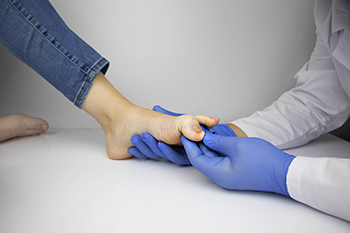 Toenail fungus, or onychomycosis, is a condition caused by dermatophytes, a group of fungi that thrive in warm, damp environments like your feet. It often begins as a white or yellow spot under the tip of the toenail and can progress to thickening, discoloration, and even nail detachment if left untreated. Ways to treat and subsequently prevent toenail fungus include washing your feet daily with soap and water, paying special attention to the toenails, and then drying your feet thoroughly, including the spaces between your toes to prevent moisture buildup. Wear shoes made of breathable materials, like leather or mesh, to reduce moisture accumulation and avoid wearing tight-fitting shoes for extended periods. In addition, change your socks daily, and opt for moisture-wicking socks if you sweat excessively. Use antifungal foot powder or spray to keep your feet dry and prevent fungal growth. Wear flip-flops or shower shoes in communal showers, locker rooms, and pool areas to minimize the risk of exposure to the fungus. If your toenail fungus persists or worsens despite these measures, it is suggested that you make an appointment with a podiatrist who can recommend prescription medications, laser therapy, or in severe cases, surgical nail removal.
Toenail fungus, or onychomycosis, is a condition caused by dermatophytes, a group of fungi that thrive in warm, damp environments like your feet. It often begins as a white or yellow spot under the tip of the toenail and can progress to thickening, discoloration, and even nail detachment if left untreated. Ways to treat and subsequently prevent toenail fungus include washing your feet daily with soap and water, paying special attention to the toenails, and then drying your feet thoroughly, including the spaces between your toes to prevent moisture buildup. Wear shoes made of breathable materials, like leather or mesh, to reduce moisture accumulation and avoid wearing tight-fitting shoes for extended periods. In addition, change your socks daily, and opt for moisture-wicking socks if you sweat excessively. Use antifungal foot powder or spray to keep your feet dry and prevent fungal growth. Wear flip-flops or shower shoes in communal showers, locker rooms, and pool areas to minimize the risk of exposure to the fungus. If your toenail fungus persists or worsens despite these measures, it is suggested that you make an appointment with a podiatrist who can recommend prescription medications, laser therapy, or in severe cases, surgical nail removal.
For more information about treatment, contact one of our clinicians from The Footcare Centre. Our podiatrists can provide the care you need to keep you pain-free and on your feet.
Toenail Fungus Treatment
Toenail fungus is a condition that affects many people and can be especially hard to get rid of. Fortunately, there are several methods to go about treating and avoiding it.
Antifungals & Deterrence
Oral antifungal medicine has been shown to be effective in many cases. It is important to consult with a podiatrist to determine the proper regiment for you, or potentially explore other options.
Applying foot powder on the feet and shoes helps keep the feet free of moisture and sweat.
Sandals or open toed shoes – Wearing these will allow air movement and help keep feet dry. They also expose your feet to light, which fungus cannot tolerate. Socks with moisture wicking material also help as well.
If you have any questions please feel free to contact our offices located in Weybridge, UK. We offer the newest diagnostic and treatment technologies for all your foot and ankle needs.
Toenail Fungus
Toenail fungus is a frustrating problem that affects many people. It can be persistent and hard to get rid of. As many different types of fungi are present throughout the environment, it is very easy to contract toenail fungus.
The feet are especially susceptible to toenail fungus because shoes and socks create the ideal dark and moist environment that fungal infections thrive in. While fungal infections of the nail plate are quite common, if left untreated they can spread beyond the toenail and into the skin and other parts of the body.
Signs of toenail fungus include a thickened nail that has become yellow or brown in color, a foul smell, and debris beneath the nail. The toe may become painful due to the pressure of a thicker nail or the buildup of debris.
Treatment for toenail fungus is most effective during the early stages of an infection. If there is an accumulation of debris beneath the nail plate, an ingrown nail or a more serious infection can occur. While each treatment varies between patients, your podiatrist may prescribe you oral medications, topical liquids and creams, or laser therapy. To determine the best treatment process for you, be sure to visit your podiatrist at the first signs of toenail fungus.
Definition and Underlying Causes of Gout
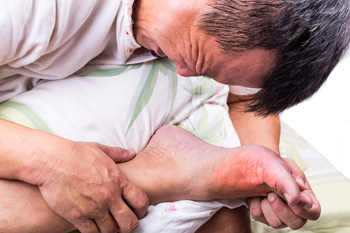 Gout is a painful form of arthritis that results from the buildup of uric acid crystals in the joints. This condition can affect anyone, and it typically targets the big toe joint. A noticeable symptom of gout is intense pain, swelling, and redness in the affected joint, often occurring suddenly and causing discomfort that can last for days or weeks. The primary cause of gout is an overabundance of uric acid in the bloodstream, a condition known as hyperuricemia. Uric acid forms when the body breaks down purines, which are found in certain foods and are also produced naturally by the body. Factors such as genetics, a diet rich in purines, excessive alcohol consumption, and obesity can contribute to elevated uric acid levels. Treatment of gout typically involves managing pain during flare-ups with anti-inflammatory medications and lifestyle modifications can help to reduce uric acid levels. Long-term strategies often include dietary changes, weight management, and medications to lower uric acid production. By understanding gout's definition, causes, and appropriate treatment options, individuals can take proactive steps to alleviate pain and prevent future attacks. If you suffer from gout, it is strongly suggested that you are under the care of a podiatrist who can help you to manage this condition.
Gout is a painful form of arthritis that results from the buildup of uric acid crystals in the joints. This condition can affect anyone, and it typically targets the big toe joint. A noticeable symptom of gout is intense pain, swelling, and redness in the affected joint, often occurring suddenly and causing discomfort that can last for days or weeks. The primary cause of gout is an overabundance of uric acid in the bloodstream, a condition known as hyperuricemia. Uric acid forms when the body breaks down purines, which are found in certain foods and are also produced naturally by the body. Factors such as genetics, a diet rich in purines, excessive alcohol consumption, and obesity can contribute to elevated uric acid levels. Treatment of gout typically involves managing pain during flare-ups with anti-inflammatory medications and lifestyle modifications can help to reduce uric acid levels. Long-term strategies often include dietary changes, weight management, and medications to lower uric acid production. By understanding gout's definition, causes, and appropriate treatment options, individuals can take proactive steps to alleviate pain and prevent future attacks. If you suffer from gout, it is strongly suggested that you are under the care of a podiatrist who can help you to manage this condition.
Gout is a foot condition that requires certain treatment and care. If you are seeking treatment, contact one of our clinicians from The Footcare Centre. Our podiatrists will treat your podiatric needs.
What Is Gout?
Gout is a type of arthritis caused by a buildup of uric acid in the bloodstream. It often develops in the foot, especially the big toe area, although it can manifest in other parts of the body as well. Gout can make walking and standing very painful and is especially common in diabetics and the obese.
People typically get gout because of a poor diet. Genetic predisposition is also a factor. The children of parents who have had gout frequently have a chance of developing it themselves.
Gout can easily be identified by redness and inflammation of the big toe and the surrounding areas of the foot. Other symptoms include extreme fatigue, joint pain, and running high fevers. Sometimes corticosteroid drugs can be prescribed to treat gout, but the best way to combat this disease is to get more exercise and eat a better diet.
If you have any questions please feel free to contact our offices located in Weybridge, UK. We offer the newest diagnostic and treatment technologies for all your foot and ankle needs.
Gout
Gout is a form of arthritis that is caused by a buildup of uric acid crystals in the joints. This considered to be one of the most frequently recorded medical illnesses throughout history. Gout occurrences in the US have risen within the past twenty years and the condition now affects 8.3 million people which is 4% of all Americans. Researchers have found that gout affects men more than women and African-American men more than white men.
Symptoms of gout are warmth, swelling, discoloration, and tenderness in the affected joint area. The small joint on the big toe is the most common place for a gout attack to occur.
People who are obese, gain weight excessively, drink alcohol heavily, have high blood pressure, or have abnormal kidney function are more likely to develop gout. Furthermore, certain drugs and diseases are likely to increase levels of uric acid in the joints which eventually leads to gout. You are also more likely to develop gout if you eat a lot of meat and fish.
Many who experience gout attacks will experience repeated attacks over the years. Some people who have gout symptoms, may never have them again, but others may experience them several times a year. If you have gout symptoms throughout the year, you may have recurrent gout. Those who have gout should also be careful about their urate crystals collecting in their urinary tract, because this may lead to kidney stones.
Diagnosis for gout is done by checking the level of uric acid in the joints and blood. Your podiatrist may also prescribe medicine to reduce uric acid buildup in the blood, which will help prevent any gout attacks.
To treat gout, your podiatrist may also prescribe you Anti-inflammatory medication (NSAIDs) which will relieve the pain and swelling of a gout episode and it can also shorten a gout attack. Maintaining a healthy diet is also a proven method to prevent gout attacks.
A Guide to Treating Plantar Fasciitis
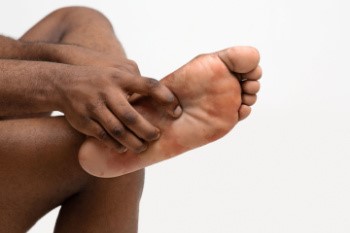 Plantar fasciitis, a common and often debilitating foot condition, can bring your daily life to a halt due to severe heel pain. Fortunately, various treatment options are available to help you regain your comfort and mobility. Conservative measures like rest and taking anti-inflammatory medications can help to alleviate discomfort. Wearing supportive footwear with proper arch support and cushioning can significantly reduce strain on the plantar fascia. Stretching exercises that target the calf muscles and Achilles tendon can also provide relief by loosening tight structures around the foot. Custom orthotics may be recommended to support the arch and distribute pressure evenly. In rare cases, when conservative treatments are not sufficient, medical interventions such as cortico-steroid injections or surgery may be considered. Plantar fasciitis can be challenging, but with the right approach and patience, you can overcome it and return to a pain-free, active lifestyle. If you have heel pain, it is suggested that you contact a podiatrist who can effectively diagnose and treat plantar fasciitis.
Plantar fasciitis, a common and often debilitating foot condition, can bring your daily life to a halt due to severe heel pain. Fortunately, various treatment options are available to help you regain your comfort and mobility. Conservative measures like rest and taking anti-inflammatory medications can help to alleviate discomfort. Wearing supportive footwear with proper arch support and cushioning can significantly reduce strain on the plantar fascia. Stretching exercises that target the calf muscles and Achilles tendon can also provide relief by loosening tight structures around the foot. Custom orthotics may be recommended to support the arch and distribute pressure evenly. In rare cases, when conservative treatments are not sufficient, medical interventions such as cortico-steroid injections or surgery may be considered. Plantar fasciitis can be challenging, but with the right approach and patience, you can overcome it and return to a pain-free, active lifestyle. If you have heel pain, it is suggested that you contact a podiatrist who can effectively diagnose and treat plantar fasciitis.
Plantar fasciitis can be very painful and inconvenient. If you are experiencing heel pain or symptoms of plantar fasciitis, contact one of our clinicians from The Footcare Centre. Our podiatrists can provide the care you need to keep you pain-free and on your feet.
What Is Plantar Fasciitis?
Plantar fasciitis is the inflammation of the thick band of tissue that runs along the bottom of your foot, known as the plantar fascia, and causes mild to severe heel pain.
What Causes Plantar Fasciitis?
- Excessive running
- Non-supportive shoes
- Overpronation
- Repeated stretching and tearing of the plantar fascia
How Can It Be Treated?
- Conservative measures – anti-inflammatories, ice packs, stretching exercises, physical therapy, orthotic devices
- Shockwave therapy – sound waves are sent to the affected area to facilitate healing and are usually used for chronic cases of plantar fasciitis
- Surgery – usually only used as a last resort when all else fails. The plantar fascia can be surgically detached from the heel
While very treatable, plantar fasciitis is definitely not something that should be ignored. Especially in severe cases, speaking to your podiatrist right away is highly recommended to avoid complications and severe heel pain. Your podiatrist can work with you to provide the appropriate treatment options tailored to your condition.
If you have any questions please feel free to contact our offices located in Weybridge, UK. We offer the newest diagnostic and treatment technologies for all your foot and ankle needs.
Plantar Fasciitis
Plantar fasciitis is one of the most common causes of heel pain. The plantar fascia is the thick band of tissue that connects the heel bone to the toes. When this band of connective tissue becomes inflamed, plantar fasciitis occurs. Fortunately, this condition is treatable.
There are several factors that may put you at a greater risk of developing plantar fasciitis. One of the biggest factors is age; plantar fasciitis is common in those between the ages of 40 to 60. People who have jobs that require them to be on their feet are also likely to develop plantar fasciitis. This includes factory workers, teachers, and others who spend a large portion of their day walking around on hard surfaces. Another risk factor is obesity because excess weight can result in extra stress being placed on the plantar fascia.
People with plantar fasciitis often experience stabbing pain in the heel area. This pain is usually at its worst in the morning, but can also be triggered by periods of standing or sitting. Plantar fasciitis may make it hard to run and walk. It may also make the foot feel stiff and sensitive, which consequently makes walking barefoot difficult.
Treatment for plantar fasciitis depends on the severity of the specific case of the condition. Ice massage applications may be used to reduce pain and inflammation. Physical therapy is often used to treat plantar fasciitis, and this may include stretching exercises. Another treatment option is anti-inflammatory medication, such as ibuprofen.
If you suspect that you have plantar fasciitis, meet with your podiatrist immediately. If left untreated, symptoms may lead to tearing and overstretching of the plantar fascia. The solution is early detection and treatment. Be sure to speak with your podiatrist if you are experiencing heel pain.
Care for Senior Foot Health
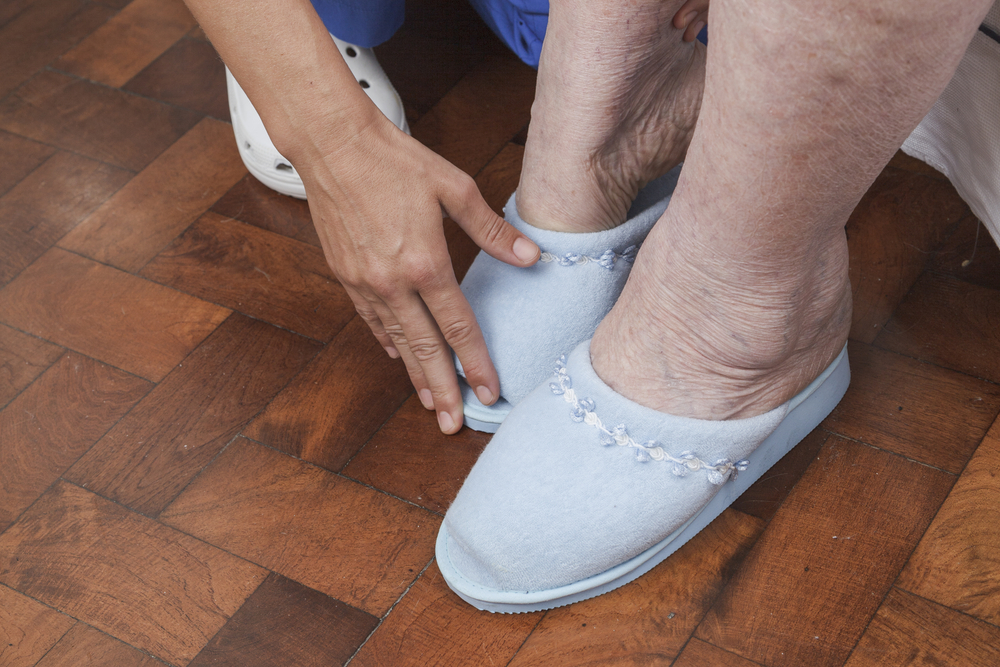 As people age, their bodies undergo various changes, and the feet are no exception. Senior citizens often encounter a range of foot problems that can significantly affect their mobility and overall quality of life. One of the most common issues is arthritis, which can cause pain, stiffness, and reduced joint flexibility. Additionally, decreased blood circulation and thinner skin make seniors more susceptible to foot sores and slow wound healing. To prevent these conditions, seniors must prioritize foot care. This includes wearing comfortable, supportive shoes, maintaining proper hygiene, and inspecting their feet regularly for any signs of problems. Regular exercise can also help improve circulation and reduce the risk of foot ailments. By taking proactive steps to care for their feet, seniors can enjoy greater comfort and mobility. If you have questions about elderly foot care, it is suggested that you consult a podiatrist who can address any concerns you may have.
As people age, their bodies undergo various changes, and the feet are no exception. Senior citizens often encounter a range of foot problems that can significantly affect their mobility and overall quality of life. One of the most common issues is arthritis, which can cause pain, stiffness, and reduced joint flexibility. Additionally, decreased blood circulation and thinner skin make seniors more susceptible to foot sores and slow wound healing. To prevent these conditions, seniors must prioritize foot care. This includes wearing comfortable, supportive shoes, maintaining proper hygiene, and inspecting their feet regularly for any signs of problems. Regular exercise can also help improve circulation and reduce the risk of foot ailments. By taking proactive steps to care for their feet, seniors can enjoy greater comfort and mobility. If you have questions about elderly foot care, it is suggested that you consult a podiatrist who can address any concerns you may have.
Proper foot care is something many older adults forget to consider. If you have any concerns about your feet and ankles, contact one of our clinicians from The Footcare Centre. Our podiatrists can provide the care you need to keep you pain-free and on your feet.
The Elderly and Their Feet
As we age we start to notice many changes in our body, but the elder population may not notice them right away. Medical conditions may prevent the elderly from taking notice of their foot health right away. Poor vision is a lead contributor to not taking action for the elderly.
Common Conditions
- Neuropathy – can reduce feeling in the feet and can hide many life-threatening medical conditions.
- Reduced flexibility – prevents the ability of proper toenail trimming, and foot cleaning. If left untreated, it may lead to further medical issues.
- Foot sores – amongst the older population can be serious before they are discovered. Some of the problematic conditions they may face are:
- Gouging toenails affecting nearby toe
- Shoes that don’t fit properly
- Pressure sores
- Loss of circulation in legs & feet
- Edema & swelling of feet and ankles
Susceptible Infections
Diabetes and poor circulation can cause a general loss of sensitivity over the years, turning a simple cut into a serious issue.
If you have any questions please feel free to contact our offices located in Weybridge, UK. We offer the newest diagnostic and treatment technologies for all your foot and ankle needs.
Elderly Foot Care
As you grow older, you will start to notice more problems with your feet due to wear and tear. This may also happen because the skin will start to become thin and lose elasticity. Some signs of aging feet are regular aches and pains, bunion development, and clawed toes.
Fortunately, there are ways you can improve comfort, relieve pain, and maintain mobility in your feet. One of the best ways to deal with aging feet is to exercise. If you keep active, your muscles will become toned which will then strengthen the arches in the foot and stimulate blood circulation.
It is important that you practice proper foot care to protect your aging feet. You should wash your feet in warm water on an everyday basis. Afterward, the feet need to be dried well and it is important to dry between the toes. Your toenails should be trimmed and kept under control; nails that are poorly cut may become ingrown. At the end of each day, performing an inspection of your feet will allow you to detect any ailments in their early stages.
As you grow older, it becomes more important that you wear comfortable shoes. Your shoes should be secure, and they should provide decent arch support. If you are looking to buy a new pair of shoes, it is best to look for a pair that are made from a breathable material. It is also helpful to have shoes that have a bit of extra room at the top of the shoe, especially if you suffer from swollen feet.
The most common foot problems that elderly people will encounter are bunions, calluses, corns, hammertoes, heel pain, and foot problems related to diabetes. Some other issues include arch pain, tarsal tunnel syndrome, Achilles tendonitis, and Morton’s neuroma
An annual foot examination is a great way for you to ensure that you do not have any serious health problems with your feet. You should talk to a podiatrist about the available treatment options for whichever foot issue you are dealing with.
